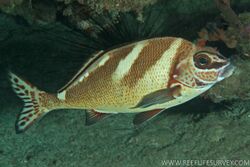Biology:Painted moki
| Painted moki | |
|---|---|

| |
| Scientific classification | |
| Domain: | Eukaryota |
| Kingdom: | Animalia |
| Phylum: | Chordata |
| Class: | Actinopterygii |
| Order: | Perciformes |
| Family: | [[Biology:|Cheilodactylidae]] |
| Genus: | Cheilodactylus |
| Subgenus: | Morwong |
| Species: | C. ephippium
|
| Binomial name | |
| Cheilodactylus ephippium McCulloch & Waite, 1916
| |
| Synonyms[1] | |
| |
The painted moki (Cheilodactylus (Morwong) ephippium), also known as the painted morwong, is a species of marine ray-finned fish, traditionally regarded as belonging to the family Cheilodactylidae, the members of which are commonly known as morwongs. It is found in the southwestern Pacific Ocean.
Taxonomy
The painted moki was first formally described as Cheilodactylus ephippium in 1916 by the Australian ichthyologists Allan Riverstone McCulloch and Edgar Ravenswood Waite with the type locality given as Norfolk Island.[2] The specific name epphipium means "saddle", an allusion which McCulloch and Waite did not explain but may be a reference to the bar behind the head.[3]
The true taxonomic relationships of the taxa traditionally classified under the family Cheilodactylidae have been considered uncertain and to have been poorly supported by some authorities over a long period of time.[4] Genetic and morphological analyses now strongly suggest that the traditional classification of Cheilodactylus is incorrect and that the inclusion of the species other than the two southern African species in Cheilodactylus, C. fasciatus and C. pixi, make the genus Cheilodactylus sensu lato paraphyletic and that all the other “morwongs” were closer to the Latridae.[5] In these analyses the painted moki was found to be the sister species of the red morwong (C. (M.) fuscus) and so was placed within the clade Morwong.[6][7]
Description
The painted moki reaches a maximum length of 55 cm (22 in).[8] The colour of this fish is basically reddish-brown to brown with irregular spotting. There is a wide light coloured oblique bar running from the nape to behind the base of the pectoral fin and joining with the pale underside. There is another shorter bar from underneath the spiny part of the dorsal fin to immediately below the centre of the body. A series of light coloured spots or a wide pale stripe run along the back from the base of the soft rayed part of the dorsal-fin.[9]
Distribution, habitat and biology
The painted moki is found in the southwestern Pacific Ocean. Off New South Wales it is found from Broughton Island south to Montague Island. In the Tasman Sea it is found at Lord Howe Island and Norfolk Island and in New Zealand it is found off the Kermadec Islands.[9] This species is found at depths down to 60 m (200 ft)[10] on inshore rocky and coral reefs.[11] This species feeds on benthic invertebrates which it filters out of the sediment.[9]
References
- ↑ Froese, Rainer and Pauly, Daniel, eds. (2021). "Morwong ephippium" in FishBase. June 2021 version.
- ↑ Eschmeyer, William N.; Fricke, Ron; van der Laan, Richard, eds. "Species in the genus Morwong". California Academy of Sciences. http://researcharchive.calacademy.org/research/ichthyology/catalog/fishcatget.asp?tbl=species&genus=Morwong.
- ↑ Christopher Scharpf; Kenneth J. Lazara, eds (25 February 2021). "Order Centrarchiformes: Families Centrarchidae, Elassomatidae, Eoplosidae, Sinipercidae, Aplodactylidae, Cheilodactylidae, Chironemidae, Cirrhitidae, Latridae, Percichthydiae, Dichistitidae, Girellidae, Kuhliidae, Kyphosidae, Oplegnathidae, Terapontidae, Microcanthidae, and Scorpididae". The ETYFish Project Fish Name Etymology Database. Christopher Scharpf and Kenneth J. Lazara. https://etyfish.org/centrarchiformes/.
- ↑ J.E. Randall (2001). "CHEILODACTYLIDAE". FAO species identification guide for fishery purposes. The living marine resources of the Western Central Pacific. Volume 5. Bony fishes part 3 (Menidae to Pomacentridae). FAO Rome. p. 3329. http://www.fao.org/3/y0770e/y0770e54.pdf.
- ↑ Ludt, W.B.; Burridge, C.P.; Chakrabarty, P. (2019). "A taxonomic revision of Cheilodactylidae and Latridae (Centrarchiformes: Cirrhitoidei) using morphological and genomic characters". Zootaxa 585 (1). doi:10.11646/zootaxa.4585.1.7.
- ↑ C. P. Burridge; R.W.G. White (2000). "Molecular phylogeny of the antitropical subgenus Goniistius (Perciformes: Cheilodactylidae: Cheilodactylus): evidence for multiple transequatorial divergences and non-monophyly". Biological Journal of the Linnean Society 70: 435–458. doi:10.1006/bijl.1999.0413.
- ↑ Christopher P. Burridge; Adam J. Smolenski (2004). "Molecular phylogeny of the Cheilodactylidae and Latridae (Perciformes: Cirrhitoidea) with notes on taxonomy and biogeography". Molecular Phylogenetics and Evolution 30: 118–127. doi:10.1016/S1055-7903(03)00157-X.
- ↑ "Cheilodactylus ephippium". Reef Life Survey. https://reeflifesurvey.com/species/cheilodactylus-ephippium/.
- ↑ 9.0 9.1 9.2 Bray, D.J. (2021). "Morwong ephippium". Fishes of Australia. Museums Victoria. https://fishesofaustralia.net.au/home/species/2415#summary.
- ↑ Mark McGrouther (8 April 2021). "Cheilodactylus ephippium McCulloch & Waite, 1916". Australian Museum. https://australian.museum/learn/animals/fishes/painted-morwong-cheilodactylus-ephippium/.
- ↑ "Goniistius ephippium". Saltcorner. Bob Goemans. http://www.saltcorner.com/AquariumLibrary/browsespecies.php?CritterID=850&filter=0.
Wikidata ☰ Q587034 entry
 |

